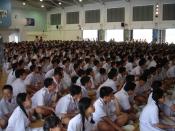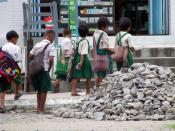Junior high school is an important place because children in both Japan and Canada arenÃÂt required to attend any school after finishing the ninth grade. During the three years, students need to have enough opportunities and experiences to think about their ways to take. Also, teachers must ensure that students have basic education so that students have wide-ranged possibilities for the future. Junior high schools should help their students to improve their potentials. Both Japanese and Canadian junior high schools provide comfortable environments and basic educations, but their goals are different.
Japanese and Canadian schools have similar equipments and facilities. They each have a gym, a cafeteria and a theater. They have classrooms with white boards where about thirty students can sit in, and they take about three hundreds hours of classes every day. When only comparing the time and the place students are learning, there are no differences between Japanese and Canadian schools as Japan and Canada are both developed countries.
In developing countries such as Bolivia and Niger, the lack of schools, teachers and equipments are serious, and not everyone can go to school. In Japan and Canada, there are no such problems.
There are many rules in Japanese schools, but not in Canadian schools. Japanese students are restricted very much not only at schools but also in daily lives. For examples, they must go straight home, they arenÃÂt allowed to go karaoke, bowling or game center without any adults, and they must wear their school uniforms and tie their hair. Too many rules often make students feel suppressed. In contrast, Canadian schools have only a few rules, letting students to determine what the right things to do. It helps to improve the studentsÃÂ abilities to control themselves, but sometimes teachers have to struggle to maintain...


